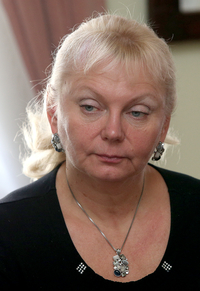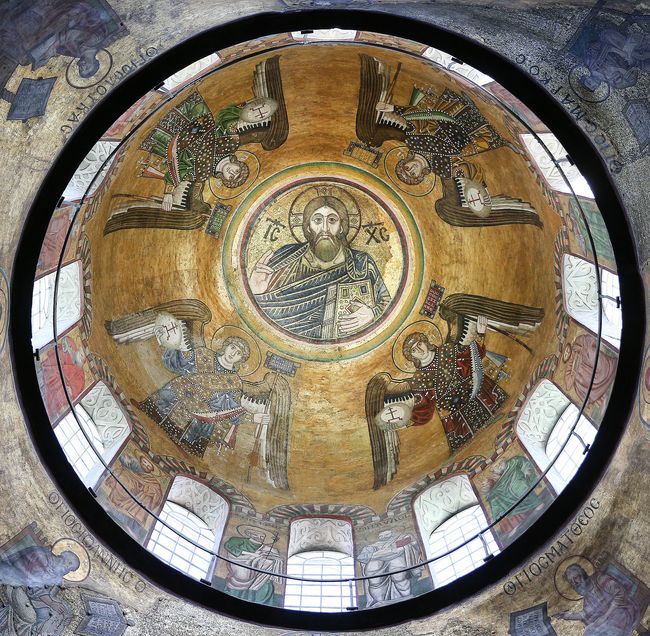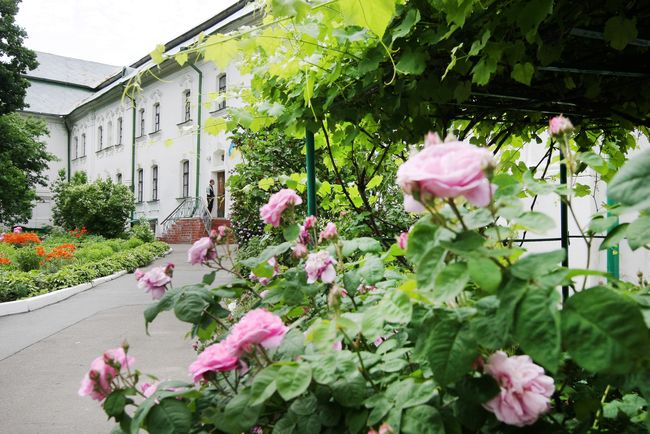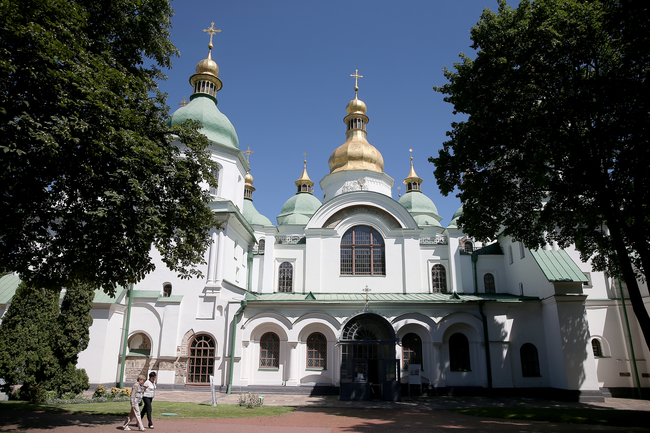Historical buildings and dense trees compose the excellent view out of the windows of Nelia Kukovalska’s office. However, vibrations from the traffic moving through Volodymyrska Street create a dissonance with the idyllic landscape. The office walls of St. Sophia’s director are decorated with icons and many awards, Ukrainian and foreign. Kukovalska is renowned outside the country: she presided over this UNESCO World Heritage Site in 2000-12, having returned to the post in 2015.
It is hard to believe that 15 years ago, in 2001, philosopher Serhii Krymsky had been strolling through St. Sophia and talking enthusiastically about the high sky effect, a feature of the Orthodox architecture when a high-rising building emphasizes the vastness of the sky. And yet, it seems few have realized the idea of wisdom, Sophia, which the temple is dedicated to and which Krymsky had explored. Probably, this lack of realization is the root of many problems the country faces today, and if you take a narrower scope – the root of many risks that imperil the heritage site.
Nelia Kukovalska doesn’t like it when the Sophia Square – the historical heart of Kyiv – becomes a place for entertainment shows and fairs. At the same time, such events encourage public interest to the holy place: past year, there was a Ukrainian classical music festival, this summer this place hosts the Sculpture Salon of Anna de Kiev Fest. Finally, in late July, free Wi-Fi was installed here, as well as QR-codes leading to the online tour.

ST. SOPHIA CATHEDRAL SEEMS TO BE ABLE TO CHANGE THE COURSE OF TIME – IT BECOMES RARIFIED AND INVISIBLE. THIS TEMPLE NOT ONLY GLORIFIES, BUT ALSO PERSONIFIES DIVINE WISDOM
St. Sophia’s general director does not like the word “strategy,” but, unlike many Ukrainian leaders, she demonstrates an action program, designed for five years. The measures involved in the program, and possible ways to preserve the sanctuary from the influence of modern barbarians, were the topics of Nelia Kukovalska’s interview to The Day.
“IT IS ALLOWED TO BUILD IN THE HISTORICAL PART OF A CITY, BUT ONE MUST COMPLY WITH RIGID REQUIREMENTS”
 In July, at the 40th session of UNESCO, St. Sophia could have been included in the list of World Heritage Sites under threat of destruction because a new building was being constructed within the buffer zone of the temple – Oles Honchar Street, 17-23. The city authorities promised to deal with the developer to reduce the number of storeys of the construction. But past year the city council promised the same thing, and nothing has changed. What would you now expect in this situation?
In July, at the 40th session of UNESCO, St. Sophia could have been included in the list of World Heritage Sites under threat of destruction because a new building was being constructed within the buffer zone of the temple – Oles Honchar Street, 17-23. The city authorities promised to deal with the developer to reduce the number of storeys of the construction. But past year the city council promised the same thing, and nothing has changed. What would you now expect in this situation?
“We must wait for the official decision on behalf of UNESCO’s 40th session. Last Friday [August 5. – Ed.] there was no decision, and I hope it will come this week, and then we will analyze it. As for the building at Honchar St., 17-23 – I came to a conclusion that Kyiv authorities had finally decided to settle the problematic issues of this development. Obviously, the licensing and design documentation contained many illegal things. In July, the developers held a press conference, and 50 percent of what they were saying was not true – they lied to the public.
“I have many documents proving that UNESCO acted strongly against this development. But at a certain time Ukrainian officials ignored this issue. A pretty deep investigation was made by NGO ‘St. Andrew’s – Landscape Alley Initiative,’ and by city council member Olha Balytska. I have attended two meetings of City Council’s Standing Committee for Urban Planning, Architecture, and Land Use, which allegedly issued a promising decision for St. Sophia – but so far no action has been taken to resolve the situation at the construction site.
“It is already impossible to demolish the house on Honchar Street. It has altered the cultural layer in an archeological site of national importance, Yaroslav’s City – which we would never be able to restore. I was very surprised to find out that the reports by both the developers and the Institute of Archaeology mentioned no valuable archaeological discoveries from the site – this could not be! The mandatory archaeological research has probably been carried out in retrospect. Nevertheless, it became known sometime later that 256 artifacts had been found, though no one knows how this issue has been resolved.

“There was initially another project for the house at Honchar St., 17-23. I saw it – it was more acceptable in terms of architecture compared to what is now, but there were remarks on the altitude. In the justification on historical and city planning it was determined that the allowable height of the building should be – I do not know, why – 41 meters. The documentation for our buffer zone around St. Sophia sets the maximum altitude for buildings on Honchar Street to 18-21 meters. The examination made for the project raises many questions; it was facilitated by forged documents.
“From the beginning, as the situation only started to happen, we noted that the permissible altitude should have been changed – the same was stated in the decision of the past year’s, 39th session of UNESCO. They should have also brought the facade style to the accordance with the city’s historical buildings; also, because the house has underground facilities, it was necessary to make additional hydrogeological wells, given the complex hydrogeology in the historical part of Kyiv. Unfortunately, the investor did not agree on that. Back in 2008 or in 2009, they told me that they would still build it as it was planned.
“As town planner, architect, builder by the first specialty and historian by another, I can clearly say that it is allowed to build in the historical part of a city – it happens all around the world. If a building becomes unusable, or falls into poor condition, or loses value, it should be replaced by something else. However, one must comply with rigid requirements, which in our case are written down in scientific and project documentation on the buffer zone around St. Sophia. This documentation has passed all stages of bureaucracy in Ukraine and was adopted by UNESCO – it is an international document that until now was neglected by every possible official.
“There was a similar situation with the house on Desiatynna Lane, 3-5. But in the end it was agreed on lower altitude – a new project was adopted and the house was constructed. And now nobody has a word against the developers, everything is fine. We must adhere to regulations, and please, by all means – make the city beautiful.”
“UNESCO DO NOT QUITE UNDERSTAND WHAT HAPPENS HERE”
You mentioned the “St. Andrew’s – Landscape Alley Initiative.” The public plays an important role in defending St. Sophia’s buffer zone. How do you see the role of these activists?
“It is good that such an initiative has emerged. Its members protect their own living space, for most people of this organization are the inhabitants of the immediate vicinity, and they understand the value of St. Sophia for Ukraine and for the entire world. They also understand the situation of illegal construction developments around St. Sophia and are struggling with them. It is good that the society reaches its maturity and takes the responsibility to preserve its heritage. This is my dreams come true. My first dream is that we will one time adopt a model of civilized country, which holds the public and its opinion in the utmost priority.
“However, our society still has NGOs that are making business on conflict situations. They do not delve deeply into the problems and raise the hype, which only distracts normal people from working. A striking example is the tracing of the Desiatynna Church foundation. Some NGOs have distributed the information that the process was allegedly illegal, that some old cemetery got destroyed. It is not true. I saw the project documentation – everything was done correctly. But someone needed publicity and it’s frustrating. Moreover, the uproar was raised by people that in the past made project documentations for many controversial developments in downtown Kyiv, and that’s the worst thing of it all.

“We started our fight for the buffer zone along with the ‘St. Andrew’s – Landscape Alley initiative.’ We learned from each other and such consolidated work bears fruit. I am well familiar with Maryna Soloviova, organization’s leader: she helped us in some cases as a lawyer, and we, as specialists in heritage protection have advised the initiative many times. Today, they have risen to a fairly high level already; for some time, probably six years, they have been attending UNESCO sessions and presenting our problems in the right way. Indeed, during the reign of Yanukovych, Ukraine supplied somewhat inaccurate information about the state of our heritage sites. They had been saying that all was well, but the foreign experts were coming to visit us and observing a very different situation. I felt it when visited the UNESCO Paris headquarters in May – they do not quite understand what is going on here, in Ukraine. So this year, in September, we will host the UNESCO mission, which is going to assess the state of the St. Sophia Cathedral and Kyiv Pechersk Lavra. This decision has already been made by the World Heritage Committee, and Ukraine has been officially informed of it.”
“PUBLIC PROMOTION OF HISTORY SHOULD BE DYNAMIC”
This year Anne de Kiev Fest was held on the site’s territory for the second time, and late July saw the opening of a permanent exhibition dedicated to Anna of Kyiv, daughter of Yaroslav the Wise and Queen of France. What is yet to be discovered in this regard?
“There are few things that have been discovered, because there are not enough credible sources, and the history is written on credible sources. Putting up documents which are almost nonexistent, and talk about them in an exhibition – this is probably the way of the previous century. We started to talk about Anna Yaroslavna by means of a festival, because it is a mass event and it is visual. When a person sees the action, they quickly come to the understanding of the situation, and then they begin to look for the sources on their own. So I have high expectations for this festival. In five years we aim to spread it to Europe, so that many people would know about our common history.

SEMINARY IS NOW IN AN EMERGENCY CONDITION. A RECENT CONCLUSION OF EXPERTS SAYS THAT THE BUILDING NEEDS AN URGENT COMPREHENSIVE RESTORATION. THE PROBLEM IS WHERE TO MOVE THE CENTRAL STATE ARCHIVE-CUM-MUSEUM OF LITERATURE AND ART WHICH IS LOCATED INSIDE
“But this does not exclude the fact that we make static exhibitions and research, we print books. It’s just that providing information in such interactive methods is a popular and interesting thing to do, especially for young people.”
Sometimes it seems that foreigners are more interested in joint research of Ukrainian heritage than we are.
“When I was in Paris once, I was struck by the story about Anna of Kyiv. Then I came to work in St. Sophia and the first five or six years I was engaged in restoration. I concentrated my efforts on saving the monuments that were in a terrible condition. One church building was more or less in a normal state, the other was a ruin. For example, what is now the Metropolitan garden was a trash pile. But when we rebuilt the ruins a little, we started thinking on how to promote our country’s history. And back then I used to say that this public promotion should be dynamic – via theaters, festivals, various interactive tools.
“Once I was invited to Anna Yaroslavna days in the French town of Senlis [where the Queen had founded the Abbey of St. Vincent. – Ed.]. There I saw how the community carries the memory of Anna of Kyiv – the mother of French kings. Interestingly, the wife of the then mayor of Senlis, Anna Canter, had a distant grandmother of Ukrainian origin. Anna Canter is a completely assimilated Frenchwoman, but in adulthood she learned Ukrainian, and her four children know the language too. The incumbent city authority is not very interested in the Anna Yaroslavna festival, but it is still being celebrated every year, organized by French and Ukrainian communities, united around our history. The driving force behind this process had been Natalia Pasternak, head of a representative committee at the Ukrainian community in France – unfortunately she passed away this year. Today Ukrainian community supports Anna Yaroslavna’s cultural center in Senlis. We are in contact with its director Victoria Dellinger and with Anne Canter, its co-founder. This is very valuable experience both for them and for us. I hope that in the future we will establish links with Sweden, Denmark, Norway, Hungary, which had as queens the daughters of Grand Prince Yaroslav the Wise, who himself was married to a Swedish princess.”
“A SURPRISING NUMBER OF YOUNG PEOPLE COME TO US”
Recently, the government instructed several ministries, as well as Kyiv Oblast State Administration, to alleviate the emergency condition, restore and rehabilitate the buildings of St. Sophia during 2016-20. What should be saved in the first place? Has there been any reaction to this order?
“Not waiting for this Cabinet’s decision, we have already developed two programs with my team. One is complex, regarding the St. Sophia Cathedral; it is very detailed, where we put down all the aspects of research, promotion, museum storage [shows a document of several hundred pages. – Author]. This program has already been approved by the Ministry of Culture. A similar document, though very condensed, exists in relation to the site as a whole. It explores the problems of maintenance and public promotion of the historical monuments within the site, and possible solutions to those problems. The program for the entire site is going to be presented this week before the Scientific and Methodological Council on Protection of Cultural Heritage at the Ministry of Culture. Hopefully, soon the ministry will approve the program and it would become the basis for the implementation of the Cabinet’s decision. The program will cost the state a little bit, 203 million hryvnias for five years – it’s not much money, but it has to come steadily. The lion’s share of the budget is the restoration work. Many things are set to be implemented at our own expense.

“Our territory has one object in disrepair. This is Seminary, where the Central State Archive-cum-Museum of Literature and Art has been located for decades. No restoration work has been performed there throughout all these years. We called licensed companies which offer specialized building surveys. Today [August 8. – Ed.] I read their conclusion, and it is very disappointing; the structure needs urgent capital restoration, further use will lead to its complete destruction. And this Seminary is a landmark of the 18th century, and a part of the heritage site included in the list of World Heritage Sites. So, we have no right to allow its destruction. But now the big question is not even performing the restoration, but rather finding the place to relocate the archive. The State Property Fund ignores the issue, saying they don’t have a proper facility to relocate it and that the Ministry of Culture should look for it. But why the Ministry of Culture must do it? There is the State Archival Service, the Ministry of Justice – that’s their business.
“In addition, the Seminary premise is not suitable for archives: there are no air conditioners or other devices to regulate temperature and humidity. There are damp cellars; the plaster is falling off from walls.
“Nobody forced us to do two action programs, but we know that this was necessary. Here is what defines St. Sophia’s life for five years. In particular, we plan to develop the direction associated with information technology. We must communicate more with the world – only this will result in better cultural policy. After all, the world’s knowledge of our heritage and history has remained where it was in the Soviet time. The new research, the modern history of Ukraine, is hardly known abroad.”
According to your observations, do Ukrainians change their attitude to Ukrainian Sofia? What is it for them: a monument or a shrine?
“Year and a half ago or so we had a kind of case study – people filled the questionnaires. Then we found out that a surprising number of young people come to us. People of ages 30 to 40 are the smallest category of visitors, and after age 40 the interest appears again. A lot of people of retirement age visit us. We also asked about the meaning of St. Sophia to the people? And young people are thinking particularly in the right direction – they perceive it holistically, as a center of spirituality, statehood, science, culture, and education. St. Sophia cannot be regarded in a one-sided way; it’s a holy symbol of high culture and of our Early Christian state.
“Older people, especially those of retirement age, are very impressed that this year we began the worship services of the Ukrainian Orthodox Church Kyiv Patriarchate. They perceive it as if the place of worship stood in the St. Sophia Cathedral, though the church services are held at ‘Warm Sophia,’ within the site. But still, there is a new symbol, the spirituality manifests in people – in Soviet times this aspect was very repressed. Everyone was an atheist then, and St. Sophia was a museum of atheism. Now the repressed came out, and people visit the sanctuary. It is also pleasing. The person who comes to a church, to God, will do no wrong – I believe in it. Anything can happen, but mostly it is like that.”







